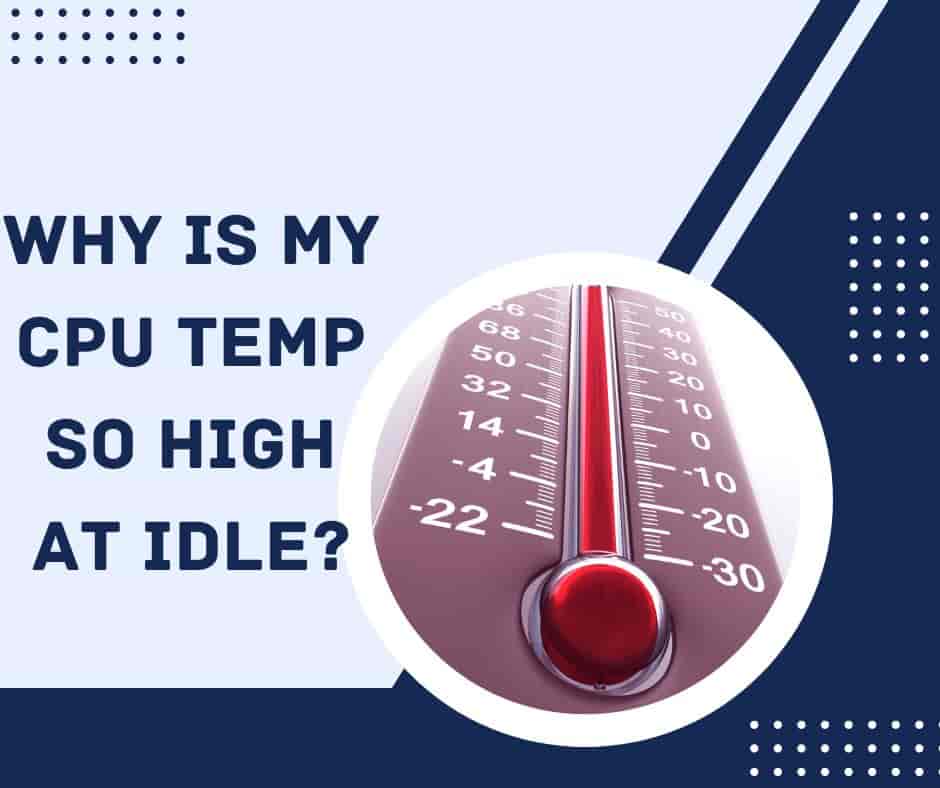As technology advances rapidly, the performance demands placed on our computers have increased significantly. This has led to the development of powerful processors that can handle complex tasks with ease. However, with this increased processing power comes a common concern among many computer users—high CPU temperatures.
It is not uncommon for users to notice their CPU temperature reaching alarming levels even when their computer is idle. In this article, we will delve into the reasons behind this issue and offer potential solutions for keeping your CPU temperatures under control.
By understanding the causes of high CPU temperatures at idle, you can take proactive measures to ensure the longevity and optimal performance of your computer. So, let’s explore the factors that contribute to high CPU temperatures and how you can address them.
Importance of Monitoring CPU Temperature
The importance of monitoring CPU temperature in any computing system cannot be overstated. The central processing unit, or CPU, is the brain of a computer, responsible for executing instructions and processing data. As the CPU performs its tasks, it generates heat, which can lead to overheating if not properly managed.
Monitoring the CPU temperature is crucial to prevent overheating, which can cause system instability, performance degradation, and potentially permanent damage to the hardware.
By keeping a close eye on the CPU temperature, system administrators can identify potential issues early on and take proactive measures to prevent any negative impact on the system’s performance and longevity.
Regular monitoring of CPU temperature also allows for the adjustment of cooling solutions, such as fans and heat sinks, to ensure optimal thermal management.
What is CPU Temp at Idle?
When assessing a computer system’s performance, monitoring the CPU temperature at idle is a crucial aspect to consider. At idle, when the system is not under any significant load, the CPU temperature reflects the processor’s baseline operating condition. Ensuring that the CPU temperature remains within a safe range at idle is essential to prevent overheating and potential damage to the hardware components.
Monitoring the CPU temperature can be done through various software tools and utilities that provide real-time data on the thermal readings.
By keeping track of the CPU temperature at idle, you can identify any abnormal spikes or fluctuations that may indicate cooling system issues or inadequate thermal management. Maintaining an optimal CPU temperature at idle not only contributes to the longevity and reliability of the system but also ensures consistent performance during demanding tasks.
Impact of High Idle CPU Temperature on System Performance
The impact of high idle CPU temperature on system performance cannot be understated. When a CPU runs at elevated temperatures during periods of minimal usage or idle states, it can have detrimental effects on the overall efficiency and longevity of the system.
High idle CPU temperatures can lead to increased power consumption, as the processor works harder to regulate its temperature, resulting in higher energy bills and reduced battery life for laptops and computers.
Furthermore, prolonged exposure to high idle CPU temperatures can cause thermal throttling, in which the processor automatically reduces its clock speed to prevent overheating. This leads to slower performance and decreased responsiveness.
Additionally, high idle CPU temperatures can accelerate hardware degradation and shorten the lifespan of the processor and other components. To mitigate these issues, it is crucial to follow the below guidelines.
Why Is My CPU Temp So High at Idle?
If you experience unusually high CPU temperatures while your system is idle, it could indicate an underlying issue that needs to be addressed promptly. Several factors can contribute to elevated CPU temperatures, even when the system is not under heavy load.
One common reason for this is poor airflow within the case, which can trap heat and prevent it from being properly dissipated. Dust buildup on the cooling components can also hinder their effectiveness in regulating temperatures.
Additionally, outdated or malfunctioning cooling systems, such as fans or heat sinks, can struggle to maintain optimal temperatures.
Another potential cause could be a misconfigured fan speed or power settings in the BIOS, which may need to be adjusted for better thermal management.
It is advisable to monitor your CPU temperatures regularly using software utilities and take necessary steps to ensure that they remain within safe limits. Prolonged exposure to high temperatures can lead to hardware damage and decreased performance.
Consider cleaning your system, checking and potentially replacing cooling components, and optimizing fan settings to address the issue of high CPU temperatures at idle.
Importance of Proper Ventilation for CPU Temp
Proper ventilation plays a critical role in maintaining optimal temperatures for CPU performance. The importance of ensuring sufficient airflow around the CPU must be balanced, as excessive heat can lead to thermal throttling, reduced efficiency, and even hardware failure.
Adequate ventilation helps dissipate heat generated by the CPU during operation, preventing it from reaching dangerous levels. This is particularly crucial for high-performance computers or servers that often run demanding applications and processes.
By maintaining a cool operating temperature, the CPU can function at its best, delivering consistent and reliable performance. Ensuring proper ventilation not only extends the lifespan of the CPU but also enhances overall system stability.
Inadequate ventilation can result in overheating, system crashes, and data loss. Therefore, it is essential to prioritize proper ventilation in any computer system to optimize CPU temperature and uphold system integrity.
The Role of Thermal Paste
The role of CPU thermal paste in the functioning of a computer system is paramount. Thermal paste is a substance that is applied between the CPU and the heatsink to improve heat transfer and ensure efficient cooling. By filling microscopic imperfections and air gaps between the two surfaces, thermal paste helps to minimize thermal resistance and facilitate the dissipation of heat generated by the CPU during operation. This is crucial because excessive heat can lead to thermal throttling, reduced performance, and even permanent damage to the processor.
Furthermore, proper application of thermal paste is essential to prevent air pockets, which can hinder heat dissipation and cause the CPU to overheat.
Therefore, using high-quality thermal paste and applying it correctly is essential for maintaining optimal thermal conductivity and ensuring the longevity of the CPU.
Checking For Background Processes
One of the crucial steps in troubleshooting a high CPU temperature at idle is checking for background processes that may be consuming excessive resources.
Background processes are applications or programs running in the background of a computer system that the user does not directly initiate. These processes can sometimes consume high levels of CPU resources, leading to elevated temperatures even when the system is idle.
To identify and address these processes, one can use task manager tools such as Activity Monitor on Mac or Task Manager on Windows.
By accessing these tools, users can view a list of all running processes, their CPU usage, and memory consumption.
By sorting processes based on CPU usage, users can easily pinpoint any applications that are abnormally consuming resources and contributing to the high CPU temperature. Once identified, users can then choose to end or turn off these processes to alleviate the strain on the CPU and reduce temperatures.
Effects of Overclocking And Overworking
Overclocking and overworking can have detrimental effects on a computer system’s overall performance and longevity. When a CPU is overclocked beyond its recommended specifications, it can lead to significantly higher temperatures, even when idle.
This elevated temperature not only poses a risk of thermal throttling, which can slow down the CPU and negatively impact system performance, but it can also cause long-term damage to the processor.
Overworking the CPU by running demanding tasks continuously can also result in high temperatures at idle, as the processor struggles to dissipate the heat generated during heavy workloads. These high CPU temperatures can shorten the lifespan of the processor and other components as they are subjected to prolonged exposure to excessive heat. It is essential to monitor CPU temperatures regularly and ensure that adequate cooling solutions are in place to prevent overheating.
Additionally, avoiding overclocking beyond the recommended limits and practicing moderation in workload allocation can help maintain the system’s optimal performance and reliability.
Final Words
In conclusion, high CPU temperatures at idle can be caused by a variety of factors, including inadequate cooling systems, outdated drivers, or background processes. It is important to regularly monitor and maintain your computer’s temperature to prevent potential damage and ensure optimal performance.
By addressing the possible causes and taking necessary steps, such as cleaning out dust buildup and updating drivers, you can effectively lower your CPU temperature and improve your computer’s overall efficiency.





